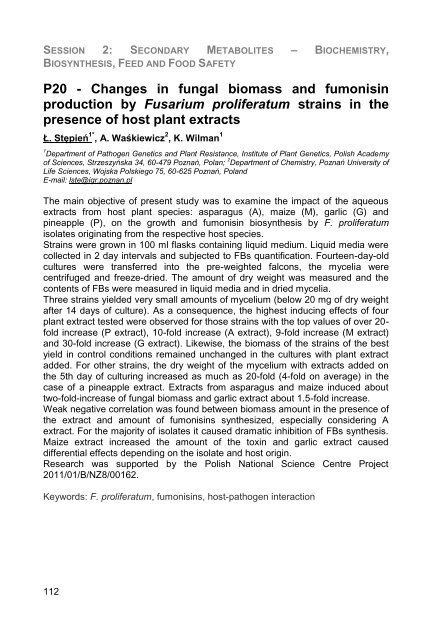EFS12- Book of abstracts - Contact
EFS12- Book of abstracts - Contact
EFS12- Book of abstracts - Contact
Create successful ePaper yourself
Turn your PDF publications into a flip-book with our unique Google optimized e-Paper software.
SESSION 2: SECONDARY METABOLITES – BIOCHEMISTRY,<br />
BIOSYNTHESIS, FEED AND FOOD SAFETY<br />
P20 - Changes in fungal biomass and fumonisin<br />
production by Fusarium proliferatum strains in the<br />
presence <strong>of</strong> host plant extracts<br />
Ł. Stępień 1* , A. Waśkiewicz 2 , K. Wilman 1<br />
1 Department <strong>of</strong> Pathogen Genetics and Plant Resistance, Institute <strong>of</strong> Plant Genetics, Polish Academy<br />
<strong>of</strong> Sciences, Strzeszyńska 34, 60-479 Poznań, Polan; 2 Department <strong>of</strong> Chemistry, Poznań University <strong>of</strong><br />
Life Sciences, Wojska Polskiego 75, 60-625 Poznań, Poland<br />
E-mail: lste@igr.poznan.pl<br />
The main objective <strong>of</strong> present study was to examine the impact <strong>of</strong> the aqueous<br />
extracts from host plant species: asparagus (A), maize (M), garlic (G) and<br />
pineapple (P), on the growth and fumonisin biosynthesis by F. proliferatum<br />
isolates originating from the respective host species.<br />
Strains were grown in 100 ml flasks containing liquid medium. Liquid media were<br />
collected in 2 day intervals and subjected to FBs quantification. Fourteen-day-old<br />
cultures were transferred into the pre-weighted falcons, the mycelia were<br />
centrifuged and freeze-dried. The amount <strong>of</strong> dry weight was measured and the<br />
contents <strong>of</strong> FBs were measured in liquid media and in dried mycelia.<br />
Three strains yielded very small amounts <strong>of</strong> mycelium (below 20 mg <strong>of</strong> dry weight<br />
after 14 days <strong>of</strong> culture). As a consequence, the highest inducing effects <strong>of</strong> four<br />
plant extract tested were observed for those strains with the top values <strong>of</strong> over 20fold<br />
increase (P extract), 10-fold increase (A extract), 9-fold increase (M extract)<br />
and 30-fold increase (G extract). Likewise, the biomass <strong>of</strong> the strains <strong>of</strong> the best<br />
yield in control conditions remained unchanged in the cultures with plant extract<br />
added. For other strains, the dry weight <strong>of</strong> the mycelium with extracts added on<br />
the 5th day <strong>of</strong> culturing increased as much as 20-fold (4-fold on average) in the<br />
case <strong>of</strong> a pineapple extract. Extracts from asparagus and maize induced about<br />
two-fold-increase <strong>of</strong> fungal biomass and garlic extract about 1.5-fold increase.<br />
Weak negative correlation was found between biomass amount in the presence <strong>of</strong><br />
the extract and amount <strong>of</strong> fumonisins synthesized, especially considering A<br />
extract. For the majority <strong>of</strong> isolates it caused dramatic inhibition <strong>of</strong> FBs synthesis.<br />
Maize extract increased the amount <strong>of</strong> the toxin and garlic extract caused<br />
differential effects depending on the isolate and host origin.<br />
Research was supported by the Polish National Science Centre Project<br />
2011/01/B/NZ8/00162.<br />
Keywords: F. proliferatum, fumonisins, host-pathogen interaction<br />
112
















![Présentation CRB-anim [Mode de compatibilité] - Inra](https://img.yumpu.com/17418636/1/190x135/presentation-crb-anim-mode-de-compatibilite-inra.jpg?quality=85)